  |
 |
 |
 |
 |
||
| site map |   |
 |
 |
 |
 |
|
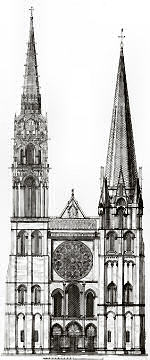
|
 |
||||||||||||||||||
|
|
|||||||||||||||||||
|
|||||||||||||||||||||||||||||||||||||||
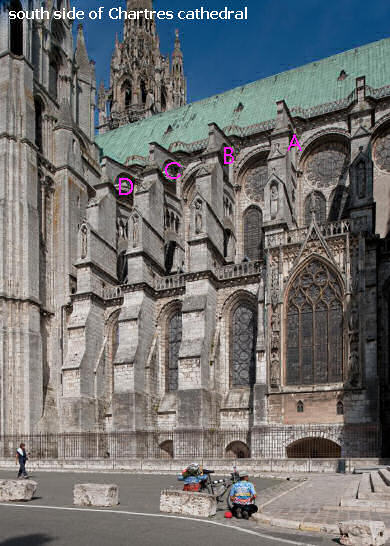 |
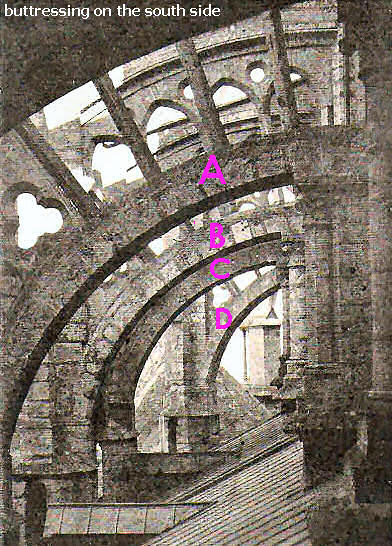 |
The left-hand photo just above also illustrates where the different types of stained glass windows are located within the nave of cathedral.
Windows like Saints Christopher and Nicaise and Saints Laumer and Mary of Egypt are on the upper level of glass; while story windows of the lives of saints such as Saint Thomas à Becket and other worthies like Charlemagne, and educational windows, say the zodiac and people’s labours, are on the lower level. This makes them easier for the congregation to see and study.
For more detail, go to the buttresses and roof of Chartres cathedral.
As with any good art gallery, the visitor can spend many hours and many visits to appreciate the glass. To help the visitor prepare, abelard has chosen a number of the most interesting and spectacular stained glass from the 200-odd windows (depending on how they are counted). abelard has also chosen a variety of medallion shapes.
The stained glass windows of Chartres date back to the early 13th century. This type of window appeared in the early 12th century, but stopped being used in the middle of the 13th century. The luminous nature of the handmade, thick but uneven glass enhances the light passing through it.
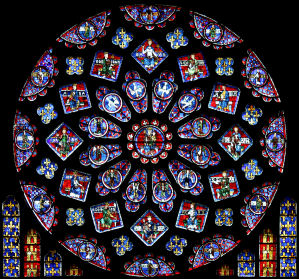
North rose at Chartres cathedral

Detail of the north rose, showing squares
with kings of Judea Asa, Rehoboam, David, Solomon, Abijah,
and medallions with prophets Joel, Hosea and Amos.
(For full lists, see box below.)
the north rose windowIn the outmost ring of this rose, in medallions within a half-circle, are shown twelve prophets, each wearing a pileus or brimless, conical, felt hat. This was a symbol of freedom in ancient Greece and Rome, put on the newly shaven head of a freed slave (traditionally, slaves were required to be bare-headed). The pileus is closely related to the Phrygian cap, well-known as the cap of the french revolutionaries.
I wonder how the pileus became the dunce's hat? the twelve prophets and the twelve kings of JudeaFrom 12 o'clock and going clockwise, the twelve prophets are Hosea, Amos, Jonah, Nahum, Zephaniah, Zacharias, Malachi, Haggai, Habbakuk, Micah, Obadiah, Joel. The ring of squares shows twelve kings of Judea. Starting from 12 o'clock and going clockwise, they are: |
[Note the numbered glass examples are located in the chart just below on the right. For why the glass is numbered thus.]
 |
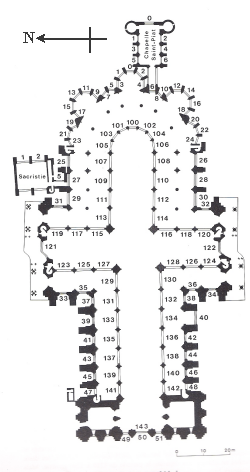 |
133 Saint George |
One version of numbering stained glass windows at Chartres cathedral, used in this page |
 |
Below is an enlargement of medallion 23 - the murder of Becket 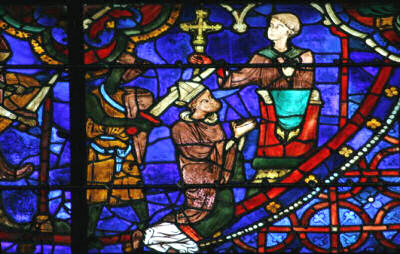
|
28 the zodiac and people’s labours [on left] |
|
 |
 |
116 Saints Christopher and Nicaise 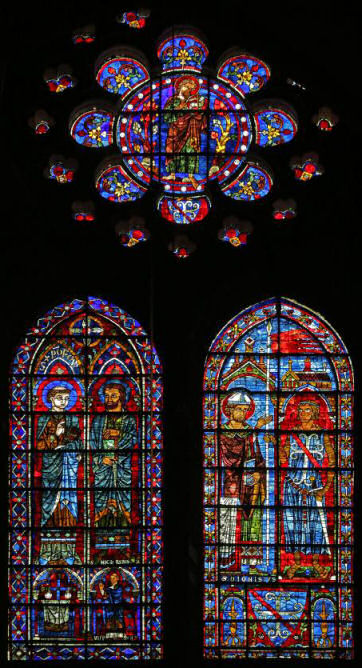 |
xx | 142 Saints Laumer and Mary of Egypt 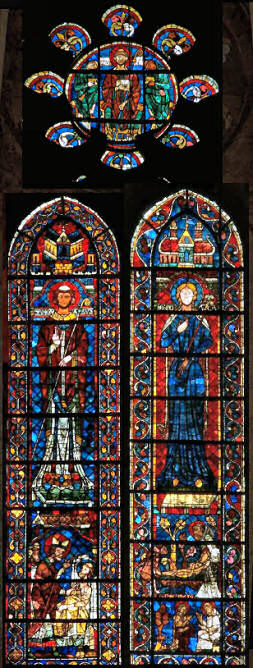 |
||
116 (rose) John Baptist with the Agnus Dei |
142 (rose) a sainted bishop with 2 monks |
|||
| (left) Saint Christopher and Saint Nicaise | (right) donor Jean Clement receives an ensign from St Denis; (below) arms of Jean Clement |
(left) St Laumer; below: St Malard, Bishop of Chartres |
(right) St Mary of Egypt; Zosimus and the lion below [enlargement] |
|
right: 123 grisaille window |
 |
|||
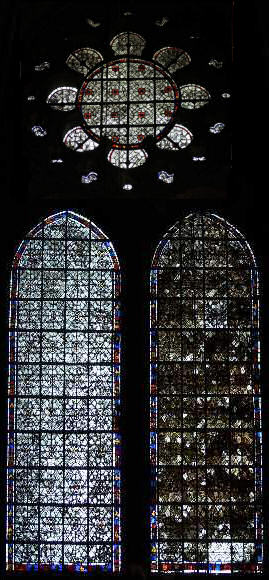 |
||||
For other images, of Chartres' rose windows, visit stained glass - development and techniques, and rose windows.
new! Cathedrale Saint-Gatien at Tours 
Romanesque churches and cathedrals in south-west France

the fire at the cathedral of Notre-Dame de Paris

cathedral giants - Amiens and Beauvais
stained glass and cathedrals in
Normandy through 9 centuries
fortified churches, mostly in Les Landes
using metal in gothic
cathedral construction
cathedral labyrinths
and mazes in France
Germans
in France
cathedral
destruction during
the French revolution,
on first arriving in France - driving
France is not England
paying
at the péage (toll station)
Transbordeur bridges in France
and the world 2:
focus on Portugalete,
Chicago,
Rochefort-Martrou
Gustave Eiffel’s first work:
the Eiffel passerelle, Bordeaux
a fifth bridge coming to Bordeaux:
pont Chaban-Delmas, a new
vertical lift bridge
France’s western isles: Ile de Ré
France’s western iles: Ile d’Oleron
Ile de France, Paris: in the context
of Abelard and of French cathedrals
short biography of Pierre (Peter) Abelard
Marianne - a French national symbol,
with French definitive stamps
la Belle Epoque
Grand Palais, Paris
Pic du Midi -
observing stars clearly, A64
Carcassonne, A61:
world heritage fortified city
Futuroscope
Vulcania
Space City, Toulouse
the French umbrella & Aurillac
50 years old:
Citroën DS
the Citroën 2CV:
a French motoring icon
the forest as seen by
Francois Mauriac, and today
Les Landes, places and playtime
roundabout art of Les Landes
bastide towns
mardi gras! carnival in
Basque country
country life in France:
the poultry fair
what a hair cut! m & french pop/rock
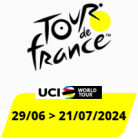
Le Tour de France: cycling tactics ![]()
right: Labyrinth at Chartres, 1696 |
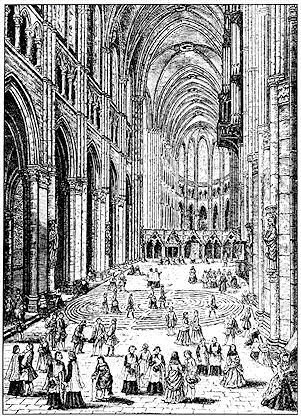 |
The floor labyrinth was laid in 1205, and was used by the monks for walking contemplation. It is still used by pilgrims. There is only one path 964 feet long. At the centre of the labyrinth there used to be a metal plate showing figures of Theseus, Ariadne, and the Minotaur, the characters in the classical myth of the Minos labyrinth.
The circumference of the labyrinth is 40 metres (131 feet).
[Note : the French word for tympanum is tympan.]
The three main entrances of Chartres - the West front, the North front and the South front - each have three huge porches. Chartres is impressive in having three separate triple-doorways, complete with statuary, tympanum and archivaults. These three main entrances are on the west front, and the north and south transepts.
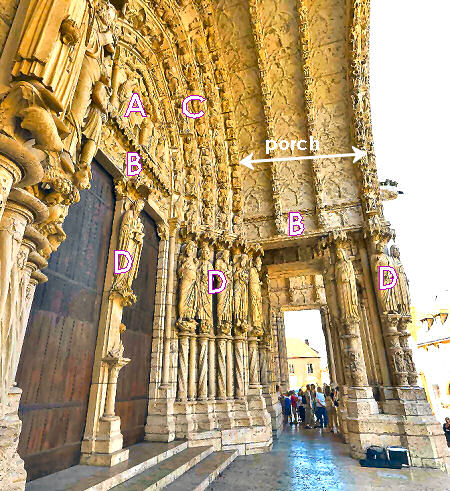
The tympana provide illustrations to Christian symbolism, the life of Jesus and to the lives of saints.
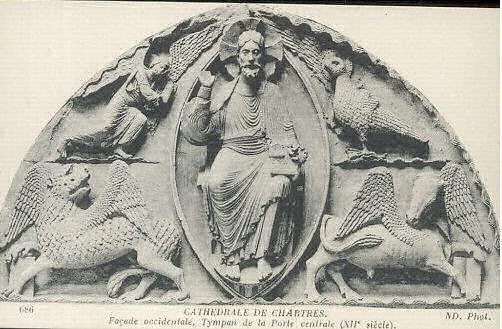
west facade, typanum on the central door of the royal portal
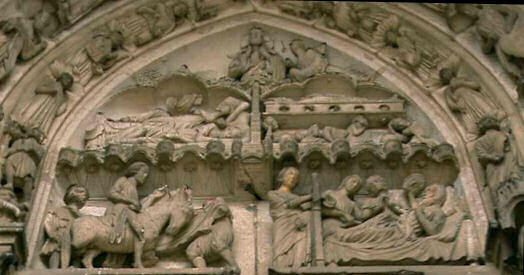
south portal, east (right) tympanum
illustrating good deeds of Saint Martin (to left) and Saint Nicholas (to right)
On one of the typana of the south portal is illustrated good deeds made by Saint Martin (to left) and Saint Nicholas
Lower left: the Roman soldier Martin, on horseback, cuts his military cloak in half. He shares it with a beggar at the gate of Amiens.
Upper left: Martin asleep, with his servant lying on the floor. Jesus appears wrapped in the half cloak Martin had given to the beggar.Lower right: Nicholas, protector of virgins and origin of Father Christmas, drops a purse containing three dowries into the house of a sick nobleman. His poverty means he must sell his three daughters into prostitution.
Upper right: Sick people visiting the tomb of Saint Nicholas are cured by oils oozing from the tomb.
Several French cathedrals have a Last Judgement tympanum. these include Poitiers, Reims, Bourges, Amiens, Notre Dame de Paris, Conques, Aveyron, Autun, Moissac, Bazas.
Here is the Last judgement tympanum at Chartres cathedral:
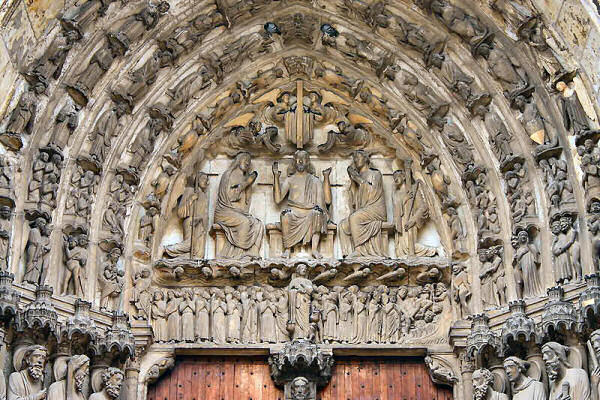
Last judgement tympanum on the south portal at Chartres
Here, Jesus is in the centre showing the wounds of the crucifixion (the Passion). He is flanked by Mary and St. John the Evangelist. Above, angels carry the "instruments of Christ's Passion" - cross, crown of thorns, nails, lance, column and whip. Below are souls going to their judgement.
The portals and tympana are just one part of the vast assembly of statuary to be seen both outside and inside Chartres cathedral. Like the stained glass, the statues inform, educate, celebrate and commemorate. There are thousands of statues, depending on how you count - statues within statues, scenes with several characters, decorations and embellishments - ranging from column statues to bas reliefs to tomb covers. As with the stained glass, abelard has chosen just a few examples to whet the visitor's visual appetite.
Note how each person stands on an object that relates to their history or significance.
Below: Bas-relief of the nativity, dating from the 13th century, from the reign of Saint Louis, came from the rood screen which had been destroyed in 1763, when religious customs changed. No longer was the high altar and choir to be hidden from the common congregation in the nave. The screen's stones were then used to make the paving for the entrance to the sanctuary. It was only in 1849, when the paving was lifted that enough pieces were recovered to be put in a small archeological museum in the crypt dedicated to St. Martin.
From 1210 to 1260, during the Saint Louis' reign, as part of the strong artistic movement that manifested in France at the time, there was a Chartraine school of sculpture, that trained several master sculptors.
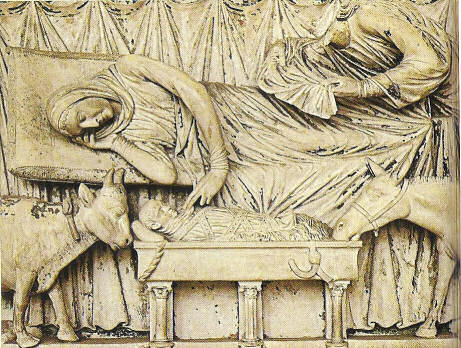
Nativity bas-relief, 13th century
The late Gabriel Loire, who I would regard as probably the best modern stained glass artist, was based in Chartres, his studio, showroom and shop being adjacent to the north facade of the cathedral. As well as seeing samples of his work in the showroom, several local buildings, such as hotels, have examples of his work. After Gabriel Loire's death in 1996, the studio continues under the management of Gabriel Loire's son and grandsons. However, they do not have the eye and talent of their recent ancestor.
During his life, Gabriel Loire made over 450 stained glass installations in France, as well as many others in Britain, Ireland, Germany, the USA, Canada, Australia, Japan, Chile, South Africa. In England, his stained glass can be seen at
![]()
|
Editions Houvet-La Crypte, Chartres, pbk, 1990 ASIN: B000XD411S |
|
| This is almost a telephone directory of the stained glass and statuary (statues) of the cathedral. The book has been around in various versions for most of a hundred years. Thus it is cheap and easy to obtain. |
||
 |
Bread, wine and money: the windows of the trades at Chartres Cathedral University of Chicago Press, pbk, 1993 ISBN-10: 0226899136 |
|
|
||
 |
La Cathédrale de Chartres Henri Laurens, Paris, pbk, approx. 1900s (series: Petites monographies des grands édifices de la France) |
|
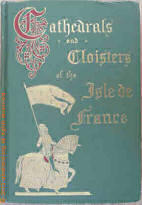 |
Cathedrals and cloisters of Ile de France Knickerbocker Press, part of G. Putnam’s Sons, 1910 vol. II: pp. 3-54
|
|
 |
Les vitraux du Centre et des Pays de la Loire Editions CNRS, 1981 ISBN-10: 2222027802 pp. 25-47 |
|
|
|
English Heritage Research Transactions Vol 7: Timber: Dating of the Roof Timbers at Lincoln Cathedral by Jeanne Marie Teutonico, R.R. Laxton, C.D. Litton, and R.E. Howard £33.25 [amazon.co.uk] {advert} James & James (Science Publishers) Ltd; Volume 7, 2001, pbk |
|
96-page paperback book with 35 pages of heavy card printed in colour, to cut out and make into 1/250th scale model. Note that the French publisher, L'Instant Durable, appears to only sell its publications through online outlets such as amazon. |
Cathédrale de Chartres L'Instant Durable/Paper Models International, 1990
ISBN-13: 978-2864040422 |
|
| abstracts | briefings | information | headlines | loud music & hearing damage | children & television violence | what is memory, and intelligence? | about abelard | ||
email email_abelard [at] abelard.org © abelard, 2014, 19 July the address for this document is https://www.abelard.org/france/cathedrals11_chartres.php |